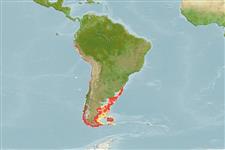Common names from other countries
Environment: milieu / climate zone / depth range / distribution range
Ekologi
; payau; kisaran kedalaman 0 - 100 m (Ref. 356), usually 4 - 20 m (Ref. 89833). Temperate, preferred 12°C (Ref. 107945); 7°S - 56°S, 81°W - 52°W
Southeast Pacific and Atlantic Ocean: From Pacasmayo, Peru to the Strait of Magellan and Beagle Channel including Juan Fernández Islands and to southern Brazil in the Atlantic including Falkland Islands. Introduced in the UK. Subtropical to temperate.
Length at first maturity / Size / Weight / umur
Maturity: Lm ?, range 4 - 4 cm Max length : 26.0 cm SHL jantan/; (Ref. 126826)
Found in bays. Found at depths of 4 to 8 m (Ref. 106875). Intertidal and subtidal sedimentary and rocky bottoms (Ref. 114788).
Life cycle and mating behavior
Kematangan | Reproduksi, perkembang biakan | Pemijahan | telur-telur | Fecundity | Larva
Members of the class Bivalvia are mostly gonochoric, some are protandric hermaphrodites. Life cycle: Embryos develop into free-swimming trocophore larvae, succeeded by the bivalve veliger, resembling a miniature clam.
rujukan utama
Acuan | Koordinator | mitra
SAUP Database. 2006. (Ref. 356)
Status IUCN Red List (Ref. 130435)
status CITES (Ref. 108899)
Not Evaluated
Not Evaluated
penggunaan manusia
Perikanan: komersial
FAO - Budidaya air: production; Perikanan: landings | FishSource | Sea Around Us
Alat, peralatan
Sumber internet
Estimates based on models
Preferred temperature
(Ref.
115969): 7.5 - 20.5, mean 12.5 (based on 198 cells).
keancaman
Low vulnerability (10 of 100).
